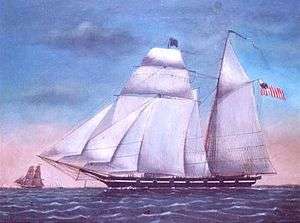USRC Wolcott (1831)
 A Morris-Taney class Revenue Cutter | |
| History | |
|---|---|
| Namesake: | Oliver Wolcott |
| Builder: | Webb and Allen, New York |
| Commissioned: | 1831 |
| Decommissioned: | September 1846 |
| Homeport: | |
| Fate: | sold in 1851 |
| General characteristics | |
| Class and type: | Schooner |
| Displacement: | 112 tons |
| Length: | 73.4 ft (22.4 m) |
| Beam: | 20.6 ft (6.3 m) |
| Draught: | 9.7 ft (3.0 m) |
| Propulsion: | wind |
| Complement: | 20-24 |
| Armament: | 6-9 pndrs |
The United States Revenue Cutter Wolcott was one of 13 cutters of the Morris-Taney Class to be launched. Named after Secretaries of the Treasury and Presidents of the United States, these cutters were the backbone of the Service for more than a decade. Samuel Humphreys designed these cutters for roles as diverse as fighting pirates, privateers, combating smugglers and operating with naval forces. He designed the vessels on a naval schooner concept. They had Baltimore Clipper lines. The vessels built by Webb and Allen, designed by Isaac Webb, resembled Humphreys' but had one less port.[1]
The Wolcott, named for Oliver Wolcott, the second Secretary of the Treasury of the United States, served in Newport, Rhode Island, New Haven, Connecticut, New London, Connecticut, and Wilmington, Delaware. Ordered to Mobile, Alabama in December 1844, she was driven ashore in Pensacola Bay during a storm. After repairs, she was attached to the U.S. Navy for service during the Mexican War to carry dispatches in the Gulf of Mexico. In September 1846, she was stricken from the commissioned list of the Revenue Cutter Service.
In June 1849, she was laid up in Mobile for repairs and on July 3, she was transferred to the Coast Survey. The Government sold Wolcott at Mobile on 8 January 1851.
References
- ↑ "Wolcott, 1831" (PDF). U.S. Coast Guard Cutter History. 2012. Retrieved 2 July 2012.
This article incorporates text from the public domain Dictionary of American Naval Fighting Ships.